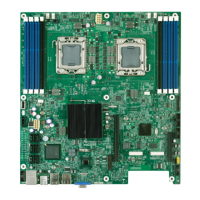Platform Management Features Intel® Server Board S5500WB TPS
Revision 1.3
Intel order number E53971-004
40
The server management subsystem is available when the system is connected to wall power
but not fully operational (S5 state); when the system is in a S1 sleep state or when the system is
fully operational (S0 state).
5.2.1 Server Engines Pilot II Controller
The center of the server management subsystem is the Server Engines Pilot II integrated
Baseboard Management Controller. This device provides support for many platform functions
including system video capabilities, legacy Super I/O functions, and also provides an ARM 926-
EJ microcontroller to host the embedded server management firmware stack.
The Server Engines Pilot II baseboard management controller across Intel’s server product line
with two different management feature set configurations: Basic and Advanced. The Intel
®
Server Board S5500WB supports both.
Basic features include IPMI 2.0 support, remote management, hardware monitoring, event
management, event alerting, system event log, asset inventory, console redirection, web
interface, and SMASH CLP (basic feature set).
Advanced features include the Basic features plus KVM redirection, USB Media redirection,
SMASH CLP (Advanced feature set), and WS-MAN. To enable the Advanced features, you
must install the Remote Management Module 3.
NOTE: The BMC consumes two USB ports; one runs at USB1.1 for keyboard mouse redirection
and one runs at USB2.0 for media redirection.
5.2.2 BMC Firmware
The BMC supports a Fast Firmware Update mode in addition to the standard KCS (Keyboard
Controller Style) SMS interface. This is a special AMI
®
proprietary protocol that goes over the
USB connection between the host and the BMC. Called “IPMI over USB”, it is implemented in
the LIBIPMI library on both host and BMC sides to transfer large blocks of data (up to 32 K)
much faster than KCS can. IPMI commands are embedded in data written/read to a virtual CD-
ROM device.
The embedded server management firmware stack is based on a core stack from American
Megatrends Incorporated (AMI). The stack runs on an embedded version of the Linux operating
system and provides support for current industry standard management interfaces (IPMI 2.0)
and emerging industry standard advanced management interfaces (SMASH-CLP and WS-
MAN). The stack also includes support for keyboard, video, mouse (KVM), and USB media
redirection.
The server management subsystem provides remote connectivity through a single GbE NIC
with NC-SI support (RMII).
NPTM support is required; you must use the ME function in the IOH to accomplish this.

